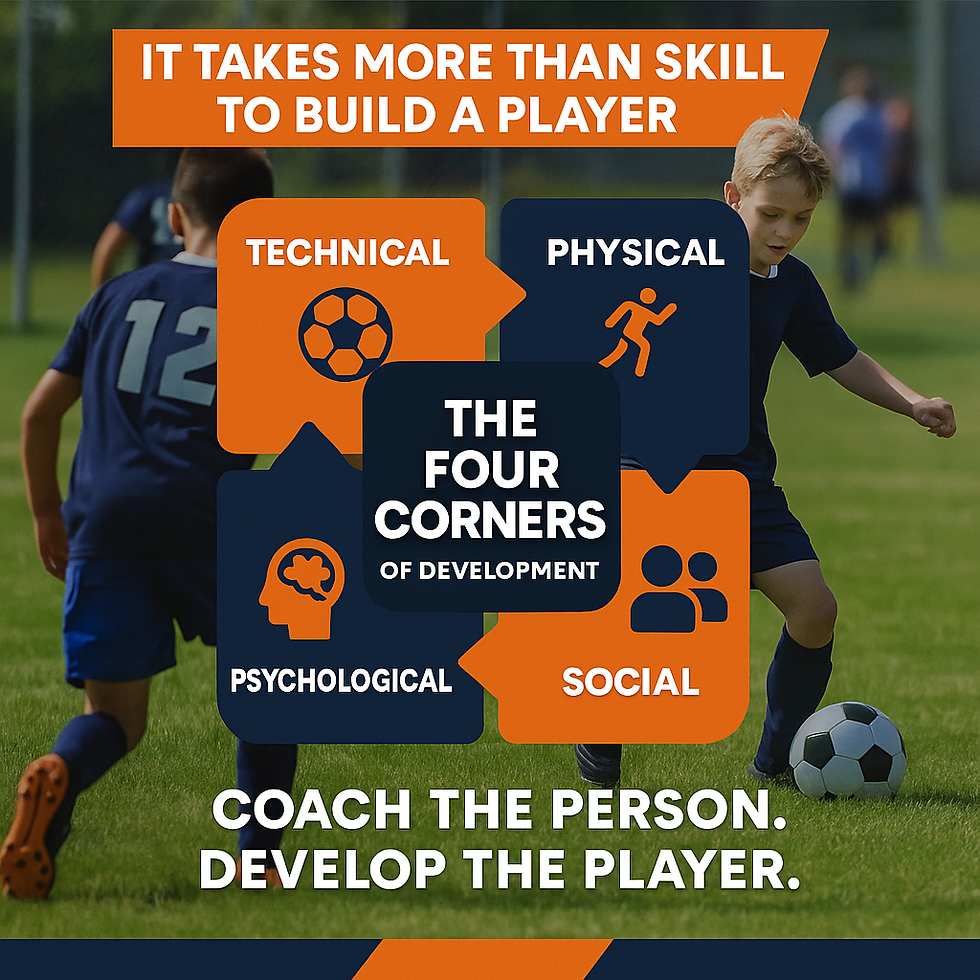More Than Just the Game: Rethinking Long Term Athlete Development Through the Four Corner Model
- Lindsay van Kessel

- Jun 19
- 3 min read

As a coach, a parent, and someone deeply invested in youth soccer, I’ve spent countless hours wondering what truly shapes a great player. Is it their technique? Their understanding of tactics? Their speed? Or their mindset?
The truth is—it’s all of it. And that’s exactly why the Four Corner Model has stood the test of time. Adopted and refined by organizations like England’s FA and Canada Soccer, this framework breaks down player development into four interdependent areas: Technical/Tactical, Physical, Psychological/Mental, and Social/Emotional. It’s a holistic lens—and for me, one of the most underused tools in grassroots sport.
What Are the Four Corners?
Technical/Tactical – Skills with the ball and decisions without it. This is what we often default to in training.
Physical – Strength, speed, coordination, agility—vital, especially as kids hit growth spurts.
Psychological – Confidence, motivation, resilience. Often invisible, but always present.
Social – Communication, leadership, respect, teamwork. The glue that holds teams together.
What makes the model powerful isn’t just its balance—it’s how each corner affects the others. A child who struggles with confidence may not express themselves technically. A player who feels left out socially may stop running for teammates. The corners aren’t boxes to tick. They’re threads in the same tapestry.
What's Changing?
Historically, coaching focused almost exclusively on the technical and physical. "Get faster." "Pass better." But in the last decade, a surge of research has shifted the focus.
Sports psychology is no longer a luxury—it’s essential.
Coaches are learning about growth mindset, ecological dynamics, and constraints-led learning.
We understand now that emotional safety, belonging, and intrinsic motivation impact performance just as much as any passing drill.
Community clubs are building this into their systems, but not without challenges.
A Challenge to Community Coaches
Here’s the hard part: The Four Corner Model is easy to admire, but tough to implement.
We coach after work, juggle family life, and try to squeeze everything into a 60-minute practice. Often with no assistant. Not enough training. Not enough time.
I’ve been there—frustrated because I knew I wasn’t addressing the psychosocial needs of a player who was clearly struggling. Or because I ran a session that might have looked great, but had too small an impact on connection and growth or tactical thinking.
This isn’t about guilt. It’s about recognizing where we are, and what we need to grow.
What the Research Says
A 2019 study in the Journal of Sports Sciences found that players who received consistent psychosocial feedback developed stronger intrinsic motivation and better decision-making in games.
Canada Soccer’s Long-Term Player Development (LTPD) model links the Four Corners to each development stage, emphasizing holistic coaching as players age.
The FA's Learning Guide highlights the importance of understanding how corners interact—especially in high-stress environments like tryouts or competition.
The Tools Coaches and Parents Need
For coaches:
Coach education modules that go beyond Xs and Os—covering communication, SEL (social-emotional learning), and athlete mental health.
Session templates that prompt reflection on which corners are addressed.
Mentorship and collaboration with other coaches—because none of us should have to figure this out alone.
For parents:
Resources to help them understand that development isn't linear, and that their child's progress can’t be judged on goals or speed alone.
Conversations that frame success in terms of growth, effort, and attitude, not just winning.
Trust in the club’s vision, and coaches who are transparent in how the Four Corners guide training decisions.
Where Do We Go From Here?
If the future of athlete development is rooted in connection. The Four Corner Model gives us the language and structure—but it’s on us to bring it to life. That means taking time to know our players, not just train them. It means teaching parents about process over outcome. And it means pushing ourselves, even when the clipboard says "just run the session."
We don’t need perfect sessions—we need intentional ones.
Final Thoughts
As a parent watching my own kids grow in sport, and as a coach committed to doing better each season, I keep coming back to this: the player is a person first.
If we coach the whole person, the player follows.
Let’s keep striving—not just for better players, but for better environments.
Comments
Like
Comment
Share
Comments settings
Add a comment…
Open Emoji Keyboard
No comments, yet.
Be the first to comment.
Start the conversation







Comments